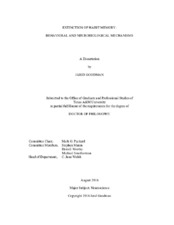| dc.description.abstract | A defining symptom of numerous human psychopathologies is the inability to control maladaptive behaviors—or “habits.” Extensive research using animal learning paradigms has led to exciting developments regarding the neurobiological bases of how habits are acquired and retrieved. However, little progress has been made in clarifying the neurobiological mechanisms through which habits might be suppressed. The present dissertation experiments explored novel behavioral and neurobiological mechanisms underlying suppression or, in experimental terms, extinction of habit memory, using a response learning task.
In the response learning task, animals are released from opposite starting positions in a plus-maze and are reinforced to make a consistent body-turn at the maze intersection in order to retrieve food reinforcement. Response learning critically depends on function of the dorsolateral striatum and is considered by many an exemplar of habit memory. Following initial acquisition of response learning, memory performance may be suppressed using an extinction procedure in which the food reinforcement is removed from the maze. Extinction learning becomes evident when the animal suppresses the original running body-turn response that was reinforced during initial acquisition.
The present dissertation project consisted of multiple experiments grouped into three distinct aims. Experiments in the first aim indicated that in order for extinction of response learning to occur the animal must be given the opportunity to perform the original running body-turn response. In contrast, place learning in the plus-maze, which represents a different kind of memory dependent on the hippocampus, may be extinguished with or without overt performance of the previous response.
Experiments in the second aim indicated that the brain region engrossed in initial acquisition of response learning—the dorsolateral striatum—is also critically implicated in extinction of response learning. In fact, inactivation of the dorsolateral striatum with the sodium channel blocker bupivacaine blocked extinction of response learning altogether. The dorsolateral striatum, however, is not needed for extinction of place learning. To the contrary, some of the evidence in the present dissertation indicated that inactivation of the dorsolateral striatum actually enhanced extinction of place learning.
Experiments in the third aim indicated that the role of the DLS in extinction of response learning could be more specifically attributed to NMDA receptor activity. Blocking NMDA receptor activity in the DLS with the NMDA receptor antagonist AP5 impaired extinction of response learning, whereas increasing NMDA receptor activity in this brain region with the NMDA receptor agonist d-cycloserine enhanced extinction of response learning.
The present findings are discussed within the context of extensive previous evidence on the neurobiology of place and response learning in the plus-maze, as well as emerging evidence indicating a role for multiple memory systems in extinction. In addition, the possibility that the present findings may be relevant to suppression of maladaptive memory in some human psychopathologies, in particular those characterized by intractable habit-like symptoms (e.g. drug addiction), receives extensive attention. | en |


